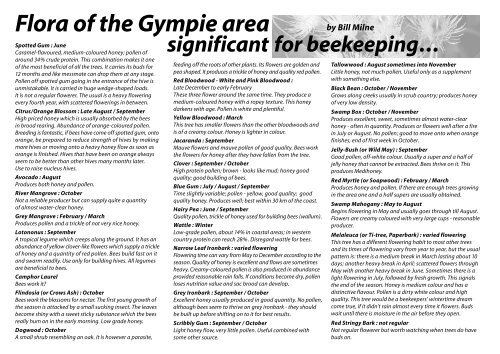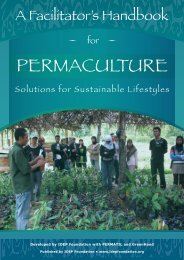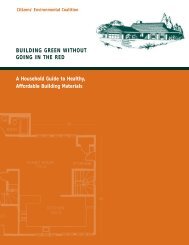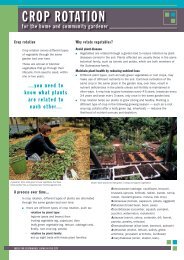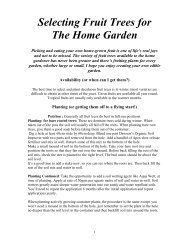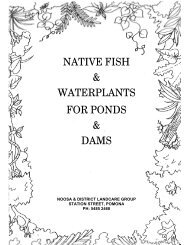Planting Trees to Attract Bees - Green Journey
Planting Trees to Attract Bees - Green Journey
Planting Trees to Attract Bees - Green Journey
Create successful ePaper yourself
Turn your PDF publications into a flip-book with our unique Google optimized e-Paper software.
Flora of the Gympie area<br />
Spotted Gum : June<br />
Caramel-flavoured, medium-coloured honey; pollen of<br />
around 34% crude protein. This combination makes it one<br />
of the most beneficial of all the trees. It carries its buds for<br />
12 months and like messmate can drop them at any stage.<br />
Pollen off spotted gum going in the entrance of the hive is<br />
unmistakable. It is carried in huge wedge-shaped loads.<br />
It is not a regular flowerer. The usual is a heavy flowering<br />
every fourth year, with scattered flowerings in between.<br />
Citrus/Orange Blossom : Late August / September<br />
High priced honey which is usually absorbed by the bees<br />
in brood rearing. Abundance of orange-coloured pollen.<br />
Breeding is fantastic, if bees have come off spotted gum, on<strong>to</strong><br />
orange, be prepared <strong>to</strong> reduce strength of hives by making<br />
more hives or moving on<strong>to</strong> a heavy honey flow as soon as<br />
orange is finished. Hives that have been on orange always<br />
seem <strong>to</strong> be better than other hives many months later.<br />
Use <strong>to</strong> raise nucleus hives.<br />
Avocado : August<br />
Produces both honey and pollen.<br />
River Mangrove : Oc<strong>to</strong>ber<br />
Not a reliable producer but can supply quite a quantity<br />
of almost water-clear honey.<br />
Grey Mangrove : February / March<br />
Produces pollen and a trickle of not very nice honey.<br />
Lo<strong>to</strong>nonus : September<br />
A tropical legume which creeps along the ground. It has an<br />
abundance of yellow clover-like flowers which supply a trickle<br />
of honey and a quantity of red pollen. <strong>Bees</strong> build fast on it<br />
and swarm readily. Use only for building hives. All legumes<br />
are beneficial <strong>to</strong> bees.<br />
Camphor Laurel<br />
<strong>Bees</strong> work it?<br />
Flindosia (or Crows Ash) : Oc<strong>to</strong>ber<br />
<strong>Bees</strong> work the blossoms for nectar. The first young growth of<br />
the season is attacked by a small sucking insect. The leaves<br />
become shiny with a sweet sticky substance which the bees<br />
really hum on in the early morning. Low grade honey.<br />
Dogwood : Oc<strong>to</strong>ber<br />
A small shrub resembling an oak. It is however a parasite,<br />
significant for beekeeping...<br />
feeding off the roots of other plants. Its flowers are golden and<br />
pea shaped. It produces a trickle of honey and quality red pollen.<br />
Red Bloodwood - White and Pink Bloodwood :<br />
Late December <strong>to</strong> early February<br />
These three flower around the same time. They produce a<br />
medium-coloured honey with a ropey texture. This honey<br />
darkens with age. Pollen is white and plentiful.<br />
Yellow Bloodwood : March<br />
This tree has smaller flowers than the other bloodwoods and<br />
is of a creamy colour. Honey is lighter in colour.<br />
Jacaranda : September<br />
Mauve flowers and mauve pollen of good quality. <strong>Bees</strong> work<br />
the flowers for honey after they have fallen from the tree.<br />
Clover : September / Oc<strong>to</strong>ber<br />
High protein pollen; brown - looks like mud; honey good<br />
quality; good building of bees.<br />
Blue Gum : July / August / September<br />
Time slightly variable; pollen - yellow, good quality; good<br />
quality honey. Produces well; best within 30 km of the coast.<br />
Hairy Pea : June / September<br />
Quality pollen, trickle of honey used for building bees (wallum).<br />
Wattle : Winter<br />
Low-grade pollen, about 14% in coastal areas; in western<br />
country protein can reach 28%. Disregard wattle for bees.<br />
Narrow Leaf Ironbark : varied flowering<br />
Flowering time can vary from May <strong>to</strong> December according <strong>to</strong> the<br />
season. Quality of honey is excellent and flows are sometimes<br />
heavy. Creamy-coloured pollen is also produced in abundance<br />
provided reasonable rain falls. If conditions become dry, pollen<br />
loses nutrition value and sac brood can develop.<br />
Grey Ironbark : September / Oc<strong>to</strong>ber<br />
Excellent honey usually produced in good quantity. No pollen,<br />
although bees seem <strong>to</strong> thrive on grey ironbark - they should<br />
be built up before shifting on <strong>to</strong> it for best results.<br />
Scribbly Gum : September / Oc<strong>to</strong>ber<br />
Light honey flow, very little pollen. Useful combined with<br />
some other source.<br />
by Bill Milne<br />
Tallowwood : August sometimes in<strong>to</strong> November<br />
Little honey, not much pollen. Useful only as a supplement<br />
with something else.<br />
Black Bean : Oc<strong>to</strong>ber / November<br />
Grows along creeks usually in scrub country; produces honey<br />
of very low density.<br />
Swamp Box : Oc<strong>to</strong>ber / November<br />
Produces excellent, sweet, sometimes almost water-clear<br />
honey - often in quantity. Produces or flowers well after a fire<br />
in July or August. No pollen; good <strong>to</strong> move on<strong>to</strong> when orange<br />
finishes, end of first week in Oc<strong>to</strong>ber.<br />
Jelly-Bush (or Wild May) : September<br />
Good pollen, off-white colour. Usually a super and a half of<br />
jelly honey that cannot be extracted. <strong>Bees</strong> thrive on it. This<br />
produces Medihoney.<br />
Red Myrtle (or Soapwood) : February / March<br />
Produces honey and pollen. If there are enough trees growing<br />
in the area one and a half supers are usually obtained.<br />
Swamp Mahogany : May <strong>to</strong> August<br />
Begins flowering in May and usually goes through till August.<br />
Flowers are creamy coloured with very large cups - reasonable<br />
producer.<br />
Melaleuca (or Ti-tree, Paperbark) : varied flowering<br />
This tree has a different flowering habit <strong>to</strong> most other trees<br />
and its times of flowering vary from year <strong>to</strong> year, but the usual<br />
pattern is: there is a medium break in March lasting about 10<br />
days; another heavy break in April; scattered flowers through<br />
May with another heavy break in June. Sometimes there is a<br />
light flowering in July, followed by fresh growth. This signals<br />
the end of the season. Honey is medium colour and has a<br />
distinctive flavour. Pollen is a dirty white colour and high<br />
quality. This tree would be a beekeepers’ wintertime dream<br />
come true, if it didn’t rain almost every time it flowers. Buds<br />
wait until there is moisture in the air before they open.<br />
Red Stringy Bark : not regular<br />
Not regular flowerer but worth watching when trees do have<br />
buds on.


